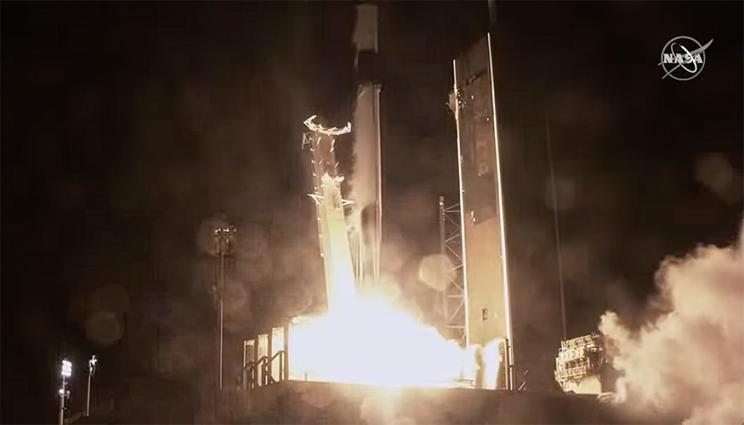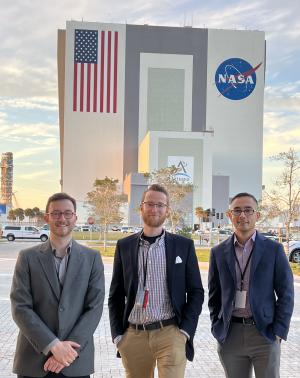
SpaceX launched its 27th contracted cargo mission for NASA Tuesday (March 14), sending a robotic Dragon capsule aloft from the Cape Canaveral Space Force Station in Florida at 8:30 p.m. EDT. The capsule carried a telescope that uses LLNL patented-monolithic optics technology. Photo courtesy of NASA
A prototype telescope designed and built by Lawrence Livermore National Laboratory (LLNL) researchers has been launched from Cape Canaveral, Fla., to the International Space Station (ISS).
Known as the Stellar Occultation Hypertemporal Imaging Payload (SOHIP), the telescope uses LLNL patented-monolithic optics technology on a gimbal to observe and measure atmospheric gravity waves and turbulence.
Launched Tuesday, the SOHIP instrument will be installed as part of the Department of Defense's Space Test Program-Houston 9 platform once it is onboard the ISS.
An interdisciplinary Livermore team produced the SOHIP instrument and met rigorous NASA safety requirements for inclusion on NASA's ISS, a Laboratory first. SOHIP also was delivered on time and on a budget of just $1 million.
"Our goal was to design, develop and deliver a pair of compact, durable single-unit telescopes leveraging the Laboratory's patented monolith technology and off-the-shelf parts requiring minimal or zero on-orbit testing for inclusion on the ISS," said Pete Supsinskas, chief space technologist for the LLNL Space Science and Security Program. "And we met that goal."
Hypersonic vehicles such as airplanes or missiles - traveling at five times the speed of sound below altitudes of 90 kilometers (km)/56 miles - operate in the extreme, unpredictable environment of the upper atmosphere, which can impact flight performance. Atmospheric gravity waves - oscillations of air that transport energy and momentum from the lower to the upper atmosphere as they propagate vertically and horizontally - create turbulence like ocean waves crashing on a beach.
"If the boundary layer on a hypersonic vehicle is exposed to atmospheric turbulence along its flight path, aerodynamic drag and heat on the vehicle will increase significantly, affecting control of the vehicle," said Matthew Horsley, a LLNL physicist and SOHIP principal investigator. "If we could accurately predict the conditions that trigger these erratic gravity waves or hypersonic flows, it could inform better vehicle design, reduce costs and improve overall hypersonic flight performance."
Understanding the atmosphere
One well-known data point about the upper atmosphere is the air's index of refraction, gauged by temperature and density. Another measurable aspect of the conditions in Earth's atmosphere is how light passes through it: ray bending occurs, sensitive to the mean index of refraction. Turbulence also affects light, causing it to scintillate. This is the reason stars appear to twinkle in the night sky.
The SOHIP development team decided to exploit these phenomena to sense changes in atmospheric temperature and density and use fluctuations in air refractivity to detect turbulence.
"By carefully measuring ray bending and scintillation, we can estimate the properties of the atmosphere that created these effects," Horsley said.
SOHIP utilizes two monolithic telescopes, attached to a gimbal assembly. The gimbal allows the telescopes' cameras to target two bright stars in the "wake" of the ISS. "The real challenge is that each camera needs to image a star at frame rates of more than 1,000 frames per second," said Lance Simms, SOHIP's flight software and operations lead. To achieve such high frame rates requires reading just a tiny subarray or "window" of the camera's sensor.
"Tracking a star's apparent motion and keeping it within that window using the gimbal would introduce unacceptable vibrations," Simms said. "So, we developed specialized firmware and algorithms to keep the gimbal fixed and have the window track the star across the sensor instead."
The high frame rate facilitates quantification of observed scintillation, while the relative measurements between the two telescopes allow for rejection of platform motion and vibration. The first telescope has a narrow field of view and once installed on the ISS, it will observe a single bright star, the "science" star, as its line-of-sight transits through the Earth's atmosphere.
The second telescope will image a second star, the "reference" star with a line-of-sight well above the atmosphere. SOHIP will measure the relative-angular separation of the science star relative to the reference star to determine its refractive bending. Scintillation of the science star will be measured by also recording the intensity of the science star at rates of more than 1,000 frames per second.
Not much bigger than a shoe box
Onboard the ISS, SOHIP weighs 30 pounds and is not much bigger than a shoe box. This extremely small package will reveal new insights on atmospheric mean temperature, pressure and density and turbulence strength at unprecedented altitude and accuracy.
"SOHIP may provide opportunities to optimize hypersonic vehicle design and flight performance. The data SOHIP captures about gravity waves from multiple angles and star settings will inform future missions, allowing us to advance algorithms to predict upper atmospheric conditions," said David Patrick, chief engineer for the SOHIP project.
A follow-on Laboratory Directed Research and Development (LDRD) feasibility study "Remote Observation of Gravity Waves with Multiple Satellite Datasets" is investigating whether SOHIP data can be combined with data from three other instruments on the ISS to measure atmospheric gravity waves that perturb the upper atmosphere.
"We are investigating if the different properties of the atmosphere measured by the four ISS instruments can be combined to observe gravity waves with a horizontal resolution as fine as 10 kilometers throughout the upper atmosphere. Characterizing the gravity waves will allow us to better understand upper atmosphere conditions and constrain models of atmospheric circulation," said Dana McGuffin, a postdoctoral researcher in the Laboratory's Atmospheric, Earth, & Energy Division of Physical and Life Sciences. Currently, measurements can only observe gravity waves with horizontal wavelengths of 300 kilometers or larger.
"We set out to develop, fabricate, deliver and demonstrate an economical, scalable, on-orbit prototype capable of remotely observing atmospheric gravity waves and high-altitude turbulence from ground level up to altitudes as high as 70 kilometers," said John Ganino, LLNL associate program leader for Space Hardware.
"The fact that this team could do something so technically complex on such a tight budget and timeline is a testament to its expertise, collaborative spirit and commitment to excellence," said Ben Bahney, program leader for the Laboratory's Space Science and Security Program.
The Laboratory's LDRD program, an internal research funding program, provided funding for SOHIP instrument design, research and development.







